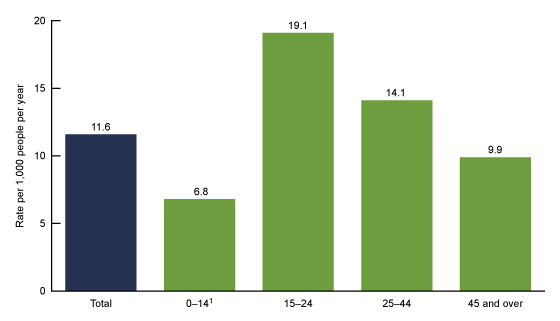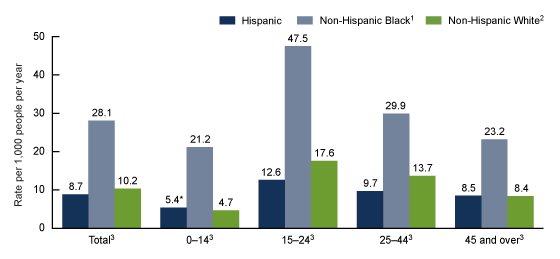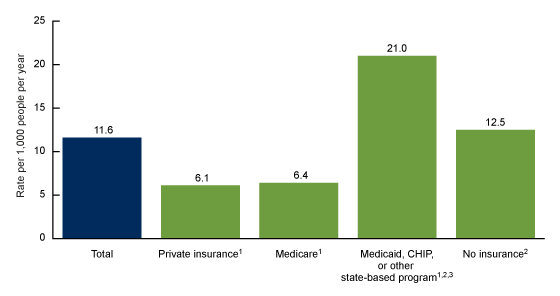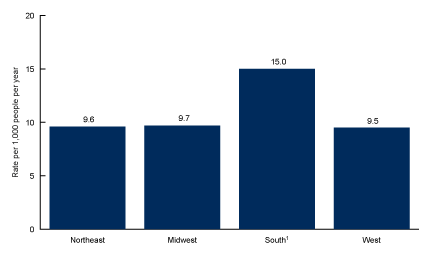Emergency Department Visit Rates for Motor Vehicle Crashes by Selected Characteristics: United States, 2019–2020
- Key findings
- The rate of ED visits for motor vehicle crashes varied by patient age group in 2019–2020.
- The ED visit rate for patients injured in motor vehicle crashes varied by patient age and race and ethnicity.
- The ED visit rate for patients injured in motor vehicle crashes varied by primary expected source of payment.
- The ED visit rate for patients injured in motor vehicle crashes varied by region.
- Summary
Data from the National Hospital Ambulatory Medical Care Survey
- In 2019–2020, the annual average emergency department (ED) visit rate for motor vehicle crash injuries was 11.6 visits per 1,000 people per year.
- The ED visit rate was highest among patients aged 15–24 (19.1) and then declined with age.
- The ED visit rate for non-Hispanic Black patients (28.1) was higher than for non-Hispanic White (10.2) and Hispanic (8.7) patients.
- ED visit rates for patients whose primary expected source of payment was Medicaid, Children’s Health Insurance Program, other state-based program, or no insurance were higher than those for patients who had private insurance or Medicare.
- The ED visit rate for motor vehicle crash injuries at hospitals in the South (15.0) was the highest among U.S. regions.
For 2019–2020, an average of 3.8 million emergency department (ED) visits for motor vehicle crash injuries occurred annually (1,2). Most injuries from motor vehicle crashes (90.4%) are unintentional and occur among vehicle occupants, and these types of injuries are a leading cause of all injury in the United States (1–3). This report presents ED visit rates for injuries related to all types of motor vehicle crashes by age, race and ethnicity, health insurance status, and region. Data for this report are from the National Hospital Ambulatory Medical Care Survey (NHAMCS), an annual nationally representative survey of nonfederal, general, and short-stay hospitals (1,2).
Keywords: car accidents, insurance, injuries, race and ethnicity, National Hospital Ambulatory Medical Care Survey (NHAMCS)
The rate of ED visits for motor vehicle crashes varied by patient age group in 2019–2020.
- The overall annual average ED visit rate for motor vehicle crashes in the United States was 11.6 visits per 1,000 people per year (Figure 1).
- The ED visit rate increased from 6.8 visits for people aged 0–14 and peaked at 19.1 visits for people aged 15–24. The rate then declined with increasing age to 9.9 visits for people aged 45 and over.
- The ED visit rates for motor vehicle crashes between those aged 0–14 and 45 and over were not significantly different.
Figure 1. Emergency department annual average visit rate for patients injured in motor vehicle crashes, by age group: United States,
2019–2020

1Rates for all age groups are significantly different from one another except for the difference between age groups 0–14 and 45 and over.
NOTES: Rates are based on a sample of 902 emergency department (ED) visits for motor vehicle crashes, representing an annual average of approximately 3.8 million ED visits.
Visit rates are based on the July 1, 2019–July 1, 2020, sets of estimates of the U.S. civilian noninstitutionalized population, as developed by the U.S. Census Bureau’s Population Division. Motor vehicle crashes are defined as a first-listed, all intents, cause of injury visit with International Classification of Diseases, 10th Revision, Clinical Modification (ICD-10-CM) codes: V02–V04 (.1, .9), V09.2, V09.3, V12–V14 and V20–V28 (.3, .4, .5, .9), V19.4–V19.6, V19.9, V29.4–V29.9, V30–V79 (.4–.9), V83–V86 (.0–.3), V80.3–V80.5, V81.1, V82.1, V87.0–V87.8, V89.2, X81.0, X82, Y02.0, Y03, and Y32. Injured persons included motor vehicle occupants, motorcyclists, pedal cyclists, and pedestrians. Access data table for Figure 1.
SOURCE: National Center for Health Statistics, National Hospital Ambulatory Medical Care Survey, 2019–2020.
The ED visit rate for patients injured in motor vehicle crashes varied by patient age and race and ethnicity.
- The annual average ED visit rate for non-Hispanic Black (subsequently, Black) patients (28.1 visits per 1,000 people per year) was higher than the visit rate for non-Hispanic White patients (subsequently, White) patients (10.2) and Hispanic patients (8.7) (Figure 2).
- Rates were higher for Black patients compared with White and Hispanic patients for all age groups, although the rate for Hispanic patients aged 0–14 did not meet statistical reliability standards.
- Among Black patients, the ED visit rate for the 15–24 age group (47.5) was higher than the 0–14 and 45 and over age groups.
- Among White patients, the ED visit rates for those aged 0–14 (4.7) and 45 and over (8.4) were lower than for those aged 15–24 (17.6) and 25–44 (13.7).
- Hispanic patients had no significant differences by age.
Figure 2. Emergency department annual average visit rate for patients injured in motor vehicle crashes, by race and ethnicity and age group: United States, 2019–2020

* Estimate does not meet National Center for Health Statistics standards of reliability. Visit estimates are not presented if they are based on fewer than 30 cases in the sample data, in which case only an asterisk is shown. Visit estimates based on 30 cases or more include an asterisk if the relative standard error of the estimate exceeds 30%.
1Rate for those aged 15–24 is significantly higher than for those aged 0–14 and 45 and over.
2Rates for all age groups are different from each other except 15–24 and 25–44.
3Rates for non-Hispanic Black patients are significantly higher than rates for non-Hispanic White and Hispanic patients.
NOTES: Rates are based on a sample of 902 emergency department (ED) visits for motor vehicle crashes, representing an annual average of approximately 3.8 million ED visits. Visit rates are based on the July 1, 2019–July 1, 2020, sets of estimates of the U.S. civilian noninstitutionalized population, as developed by the U.S. Census Bureau’s Population Division. Motor vehicle crashes are defined as a first-listed, all intents, cause of injury visit with International Classification of Diseases, 10th Revision, Clinical Modification (ICD-10-CM) codes: V02–V04 (.1, .9), V09.2, V09.3, V12–V14 and V20–V28 (.3, .4, .5, .9), V19.4–V19.6, V19.9, V29.4–V29.9, V30–V79 (.4–.9), V83–V86 (.0–.3), V80.3–V80.5, V81.1, V82.1, V87.0–V87.8, V89.2, X81.0, X82, Y02.0, Y03, and Y32. Injured people included motor vehicle occupants, motorcyclists, pedal cyclists, and pedestrians. Data were missing for 15.1% of weighted race and 12.7% of weighted ethnicity records and were imputed. Visits for non-Hispanic Asian, Native Hawaiian or Other Pacific Islander, and American Indian or Alaska Native people and people of two or more races are included in the total but not reported separately. These groups represent 3.9% of weighted visits. People of Hispanic origin may be of any race. Access data table for Figure 2.
SOURCE: National Center for Health Statistics, National Hospital Ambulatory Medical Care Survey, 2019–2020.
The ED visit rate for patients injured in motor vehicle crashes varied by primary expected source of payment.
- The annual average ED visit rates for motor vehicle crashes among patients was highest for those who had Medicaid, Children’s Health Insurance Program, or other state-based program (21.0 visits per 1,000 people per year), followed by those with no insurance (12.5) and those with private insurance (6.1) or Medicare (6.4) as their primary expected source of payment (Figure 3).
Figure 3. Emergency department annual average visit rate for patients injured in motor vehicle crashes, by primary expected source of payment: United States, 2019–2020

1Rate is significantly different than no insurance.
2Rate is significantly different than private insurance or Medicare.
3CHIP is the Children’s Health Insurance Program.
NOTES: Rates are based on a sample of 902 emergency department (ED) visits for motor vehicle crashes, representing an annual average of approximately 3.8 million ED visits. Visit rates are based on the July 1, 2019–July 1, 2020, sets of estimates of insurance coverage in the U.S. civilian noninstitutionalized population, as developed by the National Health Interview Survey. Motor vehicle crashes are defined as a first-listed, all intents, cause of injury visit with International Classification of Diseases, 10th Revision, Clinical Modification (ICD-10-CM) codes: V02–V04 (.1, .9), V09.2, V09.3, V12–V14 and V20–V28 (.3, .4, .5, .9), V19.4–V19.6, V19.9, V29.4–V29.9, V30–V79 (.4–.9), V83–V86 (.0–.3), V80.3–V80.5, V81.1, V82.1, V87.0–V87.8, V89.2, X81.0, X82, Y02.0, Y03, and Y32. Injured people included motor vehicle occupants, motorcyclists, pedal cyclists, and pedestrians. No insurance includes self-pay and no charge or charity. Workers’ compensation or other source of payment represents 1.8% and 6.0% of weighted data, respectively, but are not reported separately. Unknown or blank represents 15.7% of weighted expected source of payment data. Access data table for Figure 3.
SOURCE: National Center for Health Statistics, National Hospital Ambulatory Medical Care Survey, 2019–2020.
The ED visit rate for patients injured in motor vehicle crashes varied by region.
- The annual average ED visit rate for patients injured in motor vehicle crashes at hospitals located in the South (15.0 visits per 1,000 people per year) was higher than visit rates for hospitals located in the Northeast (9.6), Midwest (9.7), and the West (9.5) (Figure 4).
Figure 4. Emergency department annual average visit rate for patients injured in motor vehicle crashes, by region: United States, 2019–2020

1Rate is significantly different than all other regions.
NOTES: Rates are based on a sample of 902 emergency department (ED) visits for motor vehicle crashes, representing an annual average of approximately 3.8 million ED visits. Visit rates are based on the July 1, 2019–July 1, 2020, sets of estimates of the U.S. civilian noninstitutionalized population, as developed by the U.S. Census Bureau’s Population Division. Motor vehicle crashes are defined as a first-listed, all intents, cause of injury visit with International Classification of Diseases, 10th Revision, Clinical Modification (ICD-10-CM) codes: V02–V04 (.1, .9), V09.2, V09.3, V12–V14 and V20–V28 (.3, .4, .5, .9), V19.V19.6, V19.9, V29.4–V29.9, V30–V79 (.4–.9), V83–V86 (.0–.3), V80.3–V80.5, V81.1, V82.1, V87.0–V87.8, V89.2, X81.0, X82, Y02.0, Y03, and Y32. Injured persons included motor vehicle occupants, motorcyclists, pedal cyclists, and pedestrians. Access data table for Figure 4.
SOURCE: National Center for Health Statistics, National Hospital Ambulatory Medical Care Survey, 2019–2020.
Summary
This report examines 2019–2020 NHAMCS ED data and finds that an estimated 3.8 million ED visits for motor vehicle crash injuries occurred annually, or at a rate of 11.6 visits per 1,000 people per year. Visit rates were highest among patients aged 15–24 and then declined with age, while the rates for patients aged 0–14 were similar to the rates for patients aged 45 and over. Visit rates were also higher for Black patients compared with White and Hispanic patients, and this pattern was consistent by age. Visits with Medicaid, Children’s Health Insurance Program, other state-based program, or no insurance as the primary expected source of payment occurred at higher rates than visits with private insurance or Medicare. Finally, the visit rate for motor vehicle crashes at hospitals located in the South was higher than visit rates for hospitals located in all other U.S. regions.
Healthy People 2030 promotes safe and active transportation and outlines specific objectives to reduce ED visits for motor vehicle crash-related deaths and nonfatal visits (4). Data on the rates and characteristics of ED visits for motor vehicle crashes may help inform public health intervention efforts to meet outlined goals (5).
Definitions
Primary expected source of payment for this visit: During data collection, all sources of payment were collected. For patients with more than one source of payment, the hierarchy below was used (with Medicare counted first and self-pay and no charge counted last) to combine payments into one mutually exclusive variable (primary expected source of payment).
- Medicaid or Children’s Health Insurance Program: Charges paid in part or in full by a Medicaid plan. Includes payments made directly to the hospital or reimbursed to the patients. Charges covered under a Medicaid-sponsored prepaid plan or the Children’s Health Insurance Program (CHIP) are included as well as other state-based programs.
- Medicare: Charges paid in part or in full by a Medicare plan. Includes payments made directly to the hospital as well as payments reimbursed to the patient. Charges covered under a Medicare-sponsored prepaid plan are included.
- No insurance: Includes self-pay and no charge or charity. Self-pay includes charges that are paid by the patient or patient’s family that will not be reimbursed by a third party. Self-pay includes visits for which the patient is expected to be ultimately responsible for most of the bill, even if the patient never actually pays it. This does not include copayments or deductibles. No charge or charity is the category for visits for which no fee is charged (for example, charity, special research, or teaching). No charge or charity does not include visits paid for as part of a total package (for example, prepaid plan visits, postoperative visits included in a surgical fee, and pregnancy visits included in a flat fee charged for the entire pregnancy).
- Private insurance: Charges paid in part or in full by a private insurer (for example, BlueCross BlueShield). Includes payments made directly to the hospital or reimbursed to the patient. Charges covered under a private insurance-sponsored prepaid plan are included.
- Workers’ compensation or other: Includes programs designed to enable employees injured on the job to receive financial compensation regardless of fault. Also includes other sources of payment. Visits with workers’ compensation as the primary expected source of payment represented 1.8% of weighted data, and other sources of payment represented 6.0% of weighted data. These data are included in the denominator but not reported separately.
Race and ethnicity: Race and Hispanic ethnicity were collected separately and converted into a single combined variable that includes non-Hispanic White, non-Hispanic Black, Hispanic, and non-Hispanic other. Overall, for 2019 and 2020, 15.1% of weighted race data and 12.7% of weighted ethnicity data were reported missing for emergency department visits of motor vehicle crashes. Race and ethnicity were imputed for these missing records using a model-based, single, sequential regression-imputation method (7,8). Non-Hispanic other race includes Asian, Native Hawaiian or Other Pacific Islander, American Indian or Alaska Native, and two or more races and represents 3.9% of weighted visits. These visits are included in the total but are not reported separately due to small sample sizes.
Visit for motor vehicle crash: An injury-related visit with a first-listed motor vehicle crash (both intentional and unintentional) external cause-of-injury code from the International Classification of Diseases, 10th Revision, Clinical Modification (6). Adverse effect of medical and surgical misadventure or complication external cause-of-injury codes were excluded; however, if these codes were present in combination with other valid definitional codes, the visit was considered injury-related. Specifically, these codes are: V02–V04 (.1, .9), V09.2, V09.3, [V12–V14, V20–V28] (.3–.5, .9), V19.4–V19.6, V19.9, V29.4–V29.9, V30–V79 (.4–.9), V83–V86 (.0–.3), V80.3–V80.5, V81.1, V82.1, V87.0–V87.8, V89.2, X81.0, X82, Y02.0, Y03, and Y32. Injured people included motor vehicle occupants, motorcyclists, pedal cyclists, and pedestrians.
Data source and methods
Data for this report are from the 2019 and 2020 National Hospital Ambulatory Medical Care Survey, a nationally representative survey of nonfederal general and short-stay hospitals conducted by the National Center for Health Statistics. NHAMCS uses a multistage probability design with samples of geographic primary sampling units, hospitals within primary sampling units, and patient visits within EDs. In 2019, 309 hospitals reported ED data, and in 2020, 294 hospitals reported ED data, for a response rate of 84.2% (82.9% weighted) and 76.2% (76.1% weighted), respectively. Additional information on the methodology of NHAMCS is available online (7,8), as are the public-use data files (1,2).
The study population includes all first-listed, all intents cause-of-injury ED visits made by patients involved in a motor vehicle crash with any intent of injury: assault, legal intervention, self-harm, unintentional, or violence-related. Injured persons included motor vehicle occupants, motorcyclists, pedal cyclists injured in collisions with motor vehicles, and pedestrians injured in collisions with motor vehicles. ED rates by age, race and ethnicity, and region were calculated by dividing the number of ED visits caused by a motor vehicle crash by the July 1, 2019, and July 1, 2020, sets of estimates of the U.S. civilian noninstitutionalized population (obtained from the U.S. Census Bureau’s Population Division) for each demographic group. Rates by expected source of payment were calculated by dividing the number of ED visits caused by motor vehicle crashes by the National Health Interview Survey 2019–2020 estimates of insurance coverage in the U.S. civilian noninstitutionalized population. The observed differences were statistically significant unless indicated otherwise.
This report has limitations that should be considered when interpreting results. Even with 2 years of combined data, race was imputed 15.1% of the time, and ethnicity was imputed 12.7% of the time for ED visits. Despite the relatively high percentage of imputation, race and ethnicity data were included in this report with known differences in motor vehicle crash visits (9). The estimate for visits made by Hispanic patients aged 0–14 was not statistically reliable, but follows the same pattern shown in the other age categories. Additionally, 15.7% of expected source of payment data was reported as unknown or missing and was excluded from this analysis.
Data analysis was performed using the statistical packages SAS version 9.4 (SAS Institute, Cary, N.C.) and SAS-callable SUDAAN version 11.0 (RTI International, Research Triangle Park, N.C.). Differences among subgroups were evaluated using a two-tailed t test (p < 0.05).
About the authors
Danielle Davis and Christopher Cairns are with the National Center for Health Statistics, Division of Health Care Statistics.
References
- National Center for Health Statistics. 2019 NHAMCS micro-data file. 2019.
- National Center for Health Statistics. 2020 NHAMCS micro-data file. 2020.
- Centers for Disease Control and Prevention, National Centers for Injury Prevention and Control. Web-based injury statistics query and reporting system (WISQARS). 2020. Available from: https://wisqars.cdc.gov/nonfatal-leading.
- Office of Disease Prevention and Health. Healthy People 2030: Injury prevention goals and objectives. 2021.
- Centers for Disease Control and Prevention. Transportation safety. 2021. Available from: https://www.cdc.gov/transportationsafety/.
- Centers for Medicare and Medicaid Services. International classification of diseases, 10th revision, clinical modification (ICD–10–CM). 2017.
- National Center for Health Statistics. National Hospital Ambulatory Medical Care Survey, 2019. Public-use data file documentation. 2022.
- National Center for Health Statistics. National Hospital Ambulatory Medical Care Survey, 2020. Public-use data file documentation. 2022.
- Davis D, Cairns C. Emergency department visit rates for motor vehicle crashes by selected characteristics: United States, 2017–2018. NCHS Data Brief, no 410. Hyattsville, MD: National Center for Health Statistics. 2021. DOI: https://dx.doi.org/10.15620/cdc:106460.
Suggested citation
Davis D, Cairns C. Emergency department visit rates for motor vehicle crashes by selected characteristics: United States, 2019–2020. NCHS Data Brief, no 466. Hyattsville, MD: National Center for Health Statistics. 2023. DOI: https://dx.doi.org/10.15620/cdc:125983
Copyright information
All material appearing in this report is in the public domain and may be reproduced or copied without permission; citation as to source, however, is appreciated.
National Center for Health Statistics
Brian C. Moyer, Ph.D., Director
Amy M. Branum, Ph.D., Associate Director for Science
Division of Health Care Statistics
Carol DeFrances, Ph.D., Director
Alexander Strashny, Ph.D., Associate Director for Science